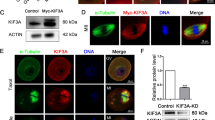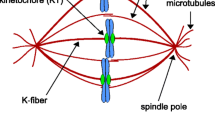Abstract
Kinetochores are macromolecular proteinaceous assemblies that are assembled on centromeres and attach chromosomes to the spindle fibres and regulate the accurate transmission of genetic material to daughter cells. Multiple protein sub-complexes within this supramolecular assembly are hierarchically assembled and contribute to the different aspects of kinetochore function. In this work we show that one of the components of the Saccharomyces cerevisiae kinetochore, Nkp2, plays an important role in ensuring accurate segregation of chromosomes. Although this protein is not conserved in higher organisms, we show that it interacts with highly conserved components of the kinetochore genetically and regulates chromosome segregation. We show that in kinetochore mutants like ctf19 and mcm21 the protein is mislocalized. Furthermore, removal of Nkp2 in these mutants restores normal levels of segregation.






Similar content being viewed by others
References
DePinho RA (2000) The age of cancer. Nature 408(6809):248–254
Westermann S, Cheeseman IM, Anderson S, Yates JR 3rd, Drubin DG, Barnes G (2003) Architecture of the budding yeast kinetochore reveals a conserved molecular core. J Cell Biol 163(2):215–222
Furuyama S, Biggins S (2007) Centromere identity is specified by a single centromeric nucleosome in budding yeast. Proc Natl Acad Sci USA 104(37):14706–14711
De Wulf P, McAinsh AD, Sorger PK (2003) Hierarchical assembly of the budding yeast kinetochore from multiple subcomplexes. Genes Dev 17(23):2902–2921
Cheeseman IM, Anderson S, Jwa M, Green EM, Kang J, Yates JR 3rd, Chan CS, Drubin DG, Barnes G (2002) Phospho-regulation of kinetochore–microtubule attachments by the Aurora kinase Ipl1p. Cell 111(2):163–172
McCleland ML, Gardner RD, Kallio MJ, Daum JR, Gorbsky GJ, Burke DJ, Stukenberg PT (2003) The highly conserved Ndc80 complex is required for kinetochore assembly, chromosome congression, and spindle checkpoint activity. Genes Dev 17(1):101–114
Kitagawa K, Hieter P (2001) Evolutionary conservation between budding yeast and human kinetochores. Nat Rev Mol Cell Biol 2(9):678–687
Meraldi P, McAinsh AD, Rheinbay E, Sorger PK (2006) Phylogenetic and structural analysis of centromeric DNA and kinetochore proteins. Genome Biol 7(3):R23
Akiyoshi B, Sarangapani KK, Powers AF, Nelson CR, Reichow SL, Arellano-Santoyo H, Gonen T, Ranish JA, Asbury CL, Biggins S (2010) Tension directly stabilizes reconstituted kinetochore–microtubule attachments. Nature 468(7323):576–579
Cheeseman IM, Enquist-Newman M, Muller-Reichert T, Drubin DG, Barnes G (2001) Mitotic spindle integrity and kinetochore function linked by the Duo1p/Dam1p complex. J Cell Biol 152(1):197–212
Janke C, Ortiz J, Lechner J, Shevchenko A, Magiera MM, Schramm C, Schiebel E (2001) The budding yeast proteins Spc24p and Spc25p interact with Ndc80p and Nuf2p at the kinetochore and are important for kinetochore clustering and checkpoint control. EMBO J 20(4):777–791
Janke C, Ortiz J, Tanaka TU, Lechner J, Schiebel E (2002) Four new subunits of the Dam1-Duo1 complex reveal novel functions in sister kinetochore biorientation. EMBO J 21(1–2):181–193
Li Y, Bachant J, Alcasabas AA, Wang Y, Qin J, Elledge SJ (2002) The mitotic spindle is required for loading of the DASH complex onto the kinetochore. Genes Dev 16(2):183–197
Joglekar AP, Bloom K, Salmon ED (2009) In vivo protein architecture of the eukaryotic kinetochore with nanometer scale accuracy. Curr Biol 19(8):694–699
Santaguida S, Musacchio A (2009) The life and miracles of kinetochores. EMBO J 28(17):2511–2531
Cheeseman IM, Chappie JS, Wilson-Kubalek EM, Desai A (2006) The conserved KMN network constitutes the core microtubule-binding site of the kinetochore. Cell 127(5):983–997
Wei RR, Al-Bassam J, Harrison SC (2007) The Ndc80/HEC1 complex is a contact point for kinetochore–microtubule attachment. Nat Struct Mol Biol 14(1):54–59
Wei RR, Sorger PK, Harrison SC (2005) Molecular organization of the Ndc80 complex, an essential kinetochore component. Proc Natl Acad Sci USA 102(15):5363–5367
Tien JF, Umbreit NT, Gestaut DR, Franck AD, Cooper J, Wordeman L, Gonen T, Asbury CL, Davis TN (2010) Cooperation of the Dam1 and Ndc80 kinetochore complexes enhances microtubule coupling and is regulated by aurora B. J Cell Biol 189(4):713–723
Lampert F, Hornung P, Westermann S (2010) The Dam1 complex confers microtubule plus end-tracking activity to the Ndc80 kinetochore complex. J Cell Biol 189(4):641–649
Wigge PA, Kilmartin JV (2001) The Ndc80p complex from Saccharomyces cerevisiae contains conserved centromere components and has a function in chromosome segregation. J Cell Biol 152(2):349–360
Euskirchen GM (2002) Nnf1p, Dsn1p, Mtw1p, and Nsl1p: a new group of proteins important for chromosome segregation in Saccharomyces cerevisiae. Eukaryot Cell 1(2):229–240
Pinsky BA, Tatsutani SY, Collins KA, Biggins S (2003) An Mtw1 complex promotes kinetochore biorientation that is monitored by the Ipl1/Aurora protein kinase. Dev Cell 5(5):735–745
Kline SL, Cheeseman IM, Hori T, Fukagawa T, Desai A (2006) The human Mis12 complex is required for kinetochore assembly and proper chromosome segregation. J Cell Biol 173(1):9–17
Nekrasov VS, Smith MA, Peak-Chew S, Kilmartin JV (2003) Interactions between centromere complexes in Saccharomyces cerevisiae. Mol Biol Cell 14(12):4931–4946
Cheeseman IM, Niessen S, Anderson S, Hyndman F, Yates JR 3rd, Oegema K, Desai A (2004) A conserved protein network controls assembly of the outer kinetochore and its ability to sustain tension. Genes Dev 18(18):2255–2268
Desai A, Rybina S, Muller-Reichert T, Shevchenko A, Hyman A, Oegema K (2003) KNL-1 directs assembly of the microtubule-binding interface of the kinetochore in C. elegans. Genes Dev 17(19):2421–2435
Ortiz J, Stemmann O, Rank S, Lechner J (1999) A putative protein complex consisting of Ctf19, Mcm21, and Okp1 represents a missing link in the budding yeast kinetochore. Genes Dev 13(9):1140–1155
Measday V, Hailey DW, Pot I, Givan SA, Hyland KM, Cagney G, Fields S, Davis TN, Hieter P (2002) Ctf3p, the Mis6 budding yeast homolog, interacts with Mcm22p and Mcm16p at the yeast outer kinetochore. Genes Dev 16(1):101–113
Pot I, Measday V, Snydsman B, Cagney G, Fields S, Davis TN, Muller EG, Hieter P (2003) Chl4p and iml3p are two new members of the budding yeast outer kinetochore. Mol Biol Cell 14(2):460–476
Schmitzberger F, Harrison SC (2012) RWD domain: a recurring module in kinetochore architecture shown by a Ctf19-Mcm21 complex structure. EMBO Rep 13(3):216–222
Pasupala N, Easwaran S, Hannan A, Shore D, Mishra K (2012) The SUMO E3 ligase Siz2 exerts a locus-dependent effect on gene silencing in Saccharomyces cerevisiae. Eukaryot Cell 11(4):452–462
Koshland D, Hieter P (1987) Visual assay for chromosome ploidy. Methods Enzymol 155:351–372
Hieter P, Mann C, Snyder M, Davis RW (1985) Mitotic stability of yeast chromosomes: a colony color assay that measures nondisjunction and chromosome loss. Cell 40(2):381–392
Sprague GF Jr (1991) Assay of yeast mating reaction. Methods Enzymol 194:77–93
Yuen KW, Warren CD, Chen O, Kwok T, Hieter P, Spencer FA (2007) Systematic genome instability screens in yeast and their potential relevance to cancer. Proc Natl Acad Sci USA 104(10):3925–3930
Andersen MP, Nelson ZW, Hetrick ED, Gottschling DE (2008) A genetic screen for increased loss of heterozygosity in Saccharomyces cerevisiae. Genetics 179(3):1179–1195
Goldstein AL, McCusker JH (1999) Three new dominant drug resistance cassettes for gene disruption in Saccharomyces cerevisiae. Yeast 15(14):1541–1553
Cherry JM, Ball C, Weng S, Juvik G, Schmidt R, Adler C, Dunn B, Dwight S, Riles L, Mortimer RK et al (1997) Genetic and physical maps of Saccharomyces cerevisiae. Nature 387(6632 Suppl):67–73
McMurray MA, Gottschling DE (2003) An age-induced switch to a hyper-recombinational state. Science 301(5641):1908–1911
Johnston JR (1971) Genetic analysis of spontaneous half-sectored colonies of Saccharomyces cerevisiae. Genet Res 18(2):179–184
Zimmermann FK (1973) A yeast strain for visual screening for the two reciprocal products of mitotic crossing over. Mutat Res 21(5):263–269
Costanzo M, Baryshnikova A, Bellay J, Kim Y, Spear ED, Sevier CS, Ding H, Koh JL, Toufighi K, Mostafavi S et al (2010) The genetic landscape of a cell. Science 327(5964):425–431
Measday V, Baetz K, Guzzo J, Yuen K, Kwok T, Sheikh B, Ding H, Ueta R, Hoac T, Cheng B et al (2005) Systematic yeast synthetic lethal and synthetic dosage lethal screens identify genes required for chromosome segregation. Proc Natl Acad Sci USA 102(39):13956–13961
Jaspersen SL, Martin AE, Glazko G, Giddings TH Jr, Morgan G, Mushegian A, Winey M (2006) The Sad1-UNC-84 homology domain in Mps3 interacts with Mps2 to connect the spindle pole body with the nuclear envelope. J Cell Biol 174(5):665–675
Gardner JM, Smoyer CJ, Stensrud ES, Alexander R, Gogol M, Wiegraebe W, Jaspersen SL (2011) Targeting of the SUN protein Mps3 to the inner nuclear membrane by the histone variant H2A.Z. J Cell Biol 193(3):489–507
Conrad MN, Lee CY, Wilkerson JL, Dresser ME (2007) MPS3 mediates meiotic bouquet formation in Saccharomyces cerevisiae. Proc Natl Acad Sci USA 104(21):8863–8868
Fernius J, Marston AL (2009) Establishment of cohesion at the pericentromere by the Ctf19 kinetochore subcomplex and the replication fork-associated factor, Csm3. PLoS Genet 5(9):e1000629
McClelland SE, Borusu S, Amaro AC, Winter JR, Belwal M, McAinsh AD, Meraldi P (2007) The CENP-A NAC/CAD kinetochore complex controls chromosome congression and spindle bipolarity. EMBO J 26(24):5033–5047
McAinsh AD, Tytell JD, Sorger PK (2003) Structure, function, and regulation of budding yeast kinetochores. Annu Rev Cell Dev Biol 19:519–539
Nasmyth K (2005) How do so few control so many? Cell 120(6):739–746
Hagan RS, Sorger PK (2005) Cell biology: the more MAD, the merrier. Nature 434(7033):575–577
Westermann S, Drubin DG, Barnes G (2007) Structures and functions of yeast kinetochore complexes. Annu Rev Biochem 76:563–591
Yao J, He X (2008) Kinetochore assembly: building a molecular machine that drives chromosome movement. Mol BioSyst 4(10):987–992
Thomas BJ, Rothstein R (1989) The genetic control of direct-repeat recombination in Saccharomyces: the effect of rad52 and rad1 on mitotic recombination at GAL10, a transcriptionally regulated gene. Genetics 123(4):725–738
Longtine MS, McKenzie A 3rd, Demarini DJ, Shah NG, Wach A, Brachat A, Philippsen P, Pringle JR (1998) Additional modules for versatile and economical PCR-based gene deletion and modification in Saccharomyces cerevisiae. Yeast 14(10):953–961
Mishra K, Shore D (1999) Yeast Ku protein plays a direct role in telomeric silencing and counteracts inhibition by rif proteins. Curr Biol 9(19):1123–1126
Clark KL, Dignard D, Thomas DY, Whiteway M (1993) Interactions among the subunits of the G protein involved in Saccharomyces cerevisiae mating. Mol Cell Biol 13:1–8
Dorer R, Pryciak PM, Hartwell LH (1995) Saccharomyces cerevisiae cells execute a default pathway to select a mate in the absence of pheromone gradients. J Cell Biol 131(4):845–861
Acknowledgments
This work was supported by a Department of Science and Technology (DST) Fast Track grant to KM. Facilities established under University Special Assistance Programme (UGC-SAP), DST-Fund for Infrastructure in Science and Technology (DST-FIST) and Department of Biotechnology-Centre for Research and Education in Biology and Biotechnology (DBT-CREBB) programmes of University of Hyderabad have been used for conducting of experiments. ST acknowledges fellowship support from UGC and DBT-CREBB. We thank D. Gottshling, A. Marston, M. Dresser, S. Jaspersen and P. Pryciak for strains and plasmids.
Author information
Authors and Affiliations
Corresponding author
Electronic supplementary material
Below is the link to the electronic supplementary material.
Rights and permissions
About this article
Cite this article
Tirupataiah, S., Jamir, I., Srividya, I. et al. Yeast Nkp2 is required for accurate chromosome segregation and interacts with several components of the central kinetochore. Mol Biol Rep 41, 787–797 (2014). https://doi.org/10.1007/s11033-013-2918-3
Received:
Accepted:
Published:
Issue Date:
DOI: https://doi.org/10.1007/s11033-013-2918-3




